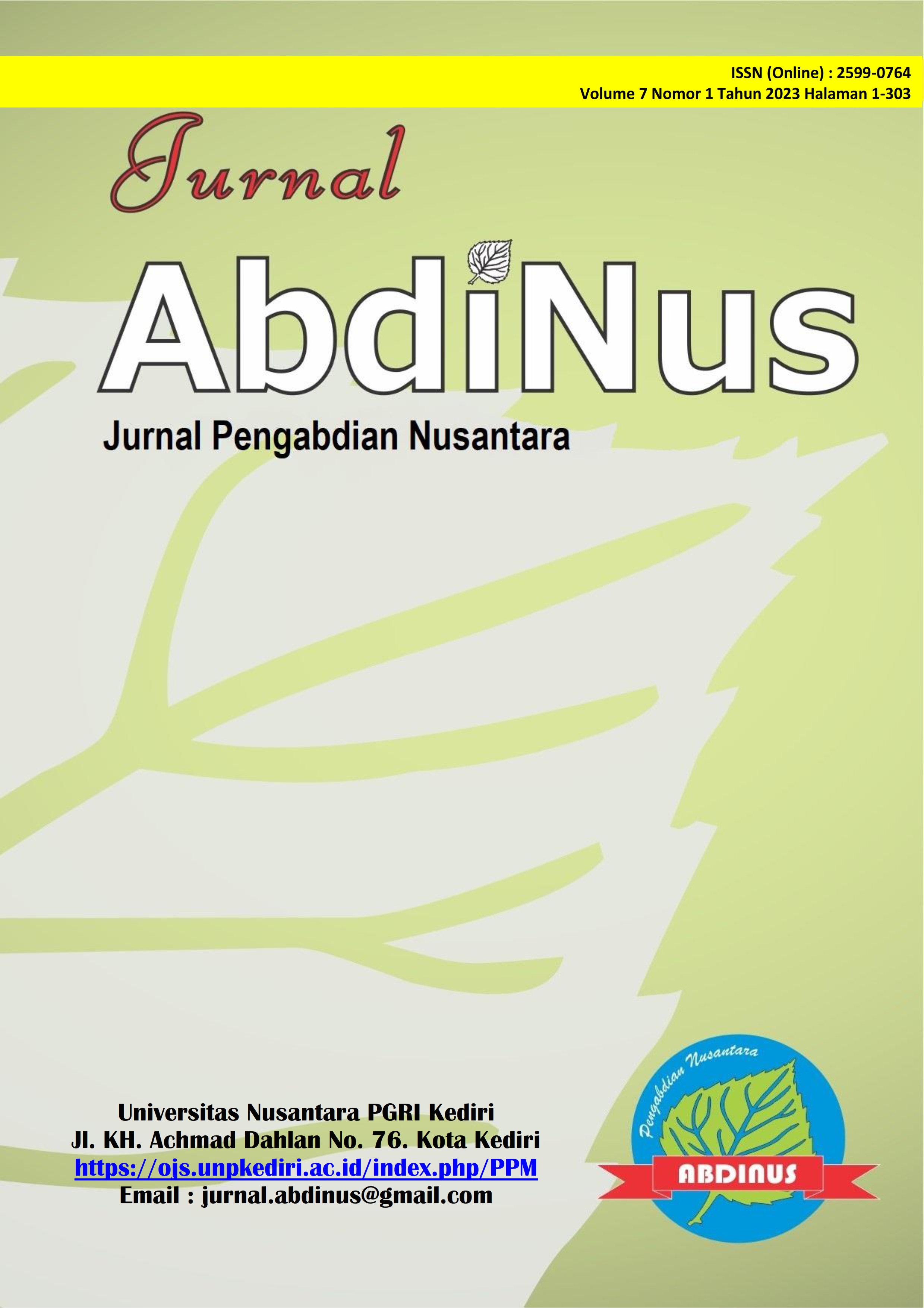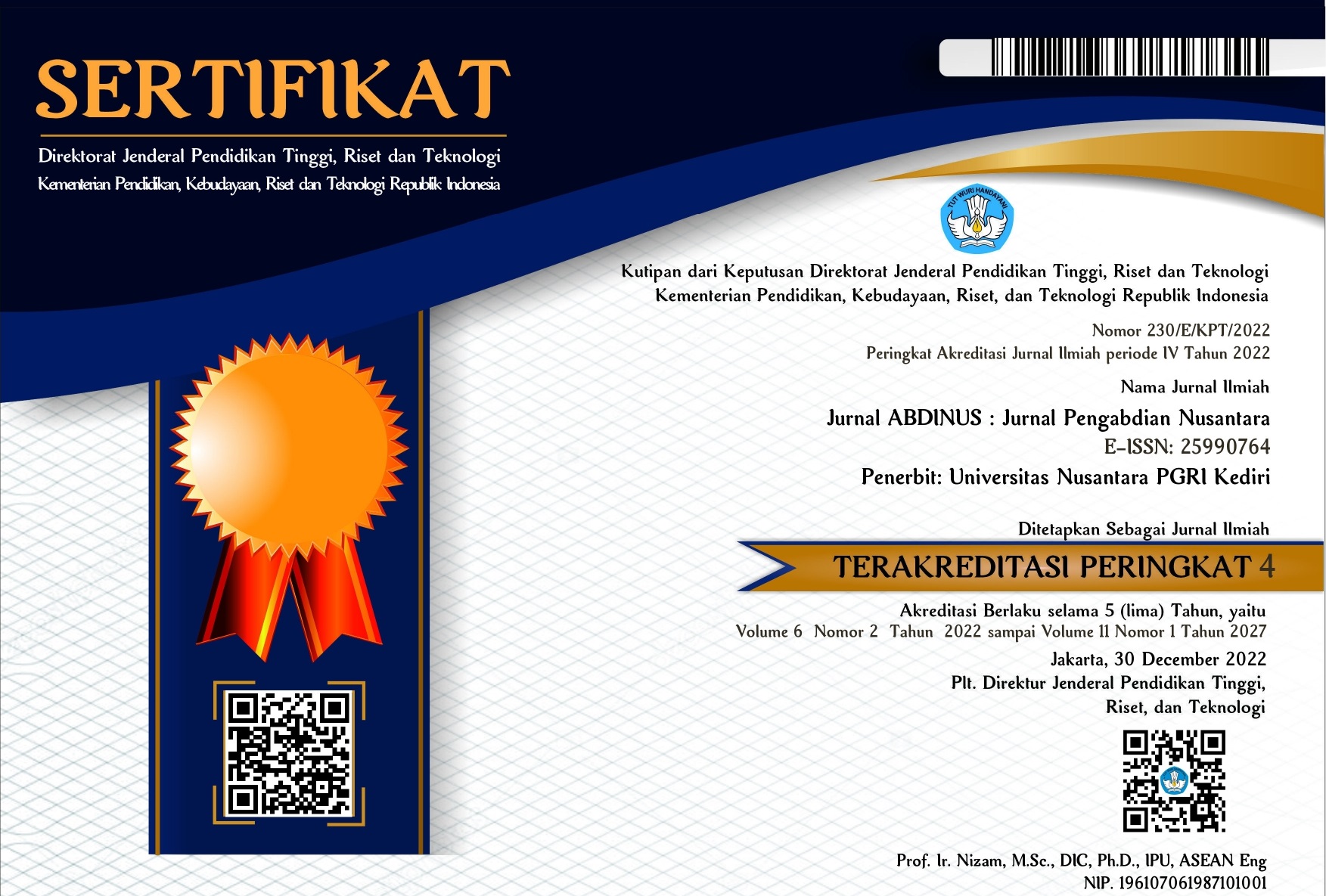Pemberdayaan Kelompok Teman Sebaya: Edukasi Penggunaan Terapi Komplementer Untuk Mengurangi Dismenorea Primer
DOI:
https://doi.org/10.29407/ja.v7i1.17334Keywords:
Peer groups, Education, Primary dysmenorrhea, Complementary therapyAbstract
Primary dysmenorrhea is an uncomfortable sensation centered in the lower abdomen. One of the therapies to overcome primary dysmenorrhea is complementary therapy. The results of the initial survey at MAN 4 Kediri obtained information that most experienced primary dysmenorrhea with mild to severe pain intensity and lack of information from health workers regarding the use of complementary therapies to reduce primary dysmenorrhea. The purpose of this community service activity is to form a peer group at MAN 4 Kediri in order to provide education and early treatment to young women who experience primary dysmenorrhea. The stages of implementing the activities include: the formation of a peer group; health education about the concept of dysmenorrhea and its management as well as demonstrations of the use of warm compress therapy and relaxation techniques. Evaluation is in the form of knowledge and ability assessment. Follow-up activities in the form of peer group assistance. The results of this activity showed that after being given education about the concept and management of dysmenorrhea, there was an increase in knowledge and being able to practice the use of warm compresses and long breath distraction techniques when experiencing primary dysmenorrhea. This community service activity is expected to empower the group of young women at MAN 4 Kediri to educate their peers about the concept of dysmenorrhea and complementary therapies that are safe for health, effective, and efficient to be applied daily.
Downloads
References
Aboualsoltani, F., Bastani, P., Khodaie, L., & Fazljou, S. M. B. (2020). Non-Pharmacological Treatments of Primary Dysmenorrhea: A systematic Review. Archives of Pharmacy Practice, 136.
Abubakar, U., Zulkarnain, A. I., Samri, F., Hisham, S. R., Alias, A., & Ishak, M. (2020). Use of Complementary and Alternative Therapies for the Treatment of Dysmenorrhea among Undergraduate Pharmacy Students in Malaysia: a Cross Sectional Study. BMC Complementary Medicine and Therapies, 20(285), 1–8.
American College of Obstetritians and Gynecologists. (2020). Dysmenorrhea: Painfull Periods. Retrieved from American College of Obstetritians and Gynecologists website: www.acog.org/womens-health/faqs/dysmenorrhea-painful-periods
Astuti, I., Septriliana, R. N., & Syntia, M. (2019). The Influence of Breathing Relaxation Technique in the Decrease of Dismenore Intensity. The 3rd International Seminar on Global Health, 3(1), 58–61. Retrieved from http://repository2.stikesayani.ac.id/index.php/isgh3/article/download/350/307
Bernardi, M., Lazzeri, L., Perelli, F., Reis, F. M., & Petraglia, F. (2017). Dysmenorrhea and Related Disorders. F1000Research, 6(0), 1–7. https://doi.org/10.12688/f1000research.11682.1
Chen, L., Tang, L., Guo, S., Kaminga, A. C., & Xu, H. (2019). Primary Dysmenorrhea and Self-Care Strategies among Chinese College Girls: A Cross-Sectional Study. BMJ Open, 9(9), 1–9. https://doi.org/10.1136/bmjopen-2018-026813
Conney, C. S., Kretchy, I. A., Asiedu-Danso, M., & Allotey-Babington, G. L. (2019). Complementary and Alternative Medicine Use for Primary Dysmenorrhea among Senior High School Students in the Western Region of Ghana. Obstetrics and Gynecology International, 2019. https://doi.org/10.1155/2019/8059471
Fernandez-Martinez, E., Onieva-Zafra, M. D., & Parra-Fernandez, M. L. (2018). Lifestyle and Prevalence of Dysmenorrhea Among Spanish Female University Students. PLOS ONE, 1–11.
Gebeyehu, M. B., Mekuria, A. B., Tefera, Y. G., Andarge, D. A., Debay, Y. B., Bejiga, G. S., & Gebresillassie, B. M. (2017). Prevalence, Impact, and Management Practice of Dysmenorrhea among University of Gondar Students, Northwestern Ethiopia: A Cross-Sectional Study. International Journal of Reproductive Medicine, 1–8. https://doi.org/10.1155/2017/3208276
Gebretatyos, H., Ghirmai, L., Amanuel, S., Gebreyohannes, G., Tsighe, Z., & Tesfamariam, E. H. (2020). Effect of Health Education on Knowledge and Attitude of Menopause among Middle-Age Teachers. BMC Women’s Health, 20(232), 1–10. https://doi.org/10.1186/s12905-020-01095-2
Hapsari, R. W., & Anasari, T. (2013). Efektivitas Teknik Relaksasi Nafas Dalam Dan Metode Pemberian Cokelat Terhadap Penurunan Intensitas Dismenore Pada Remaja Putri Di Smk Swagaya 2 Purwokerto. Jurnal Involusi Kebidanan, 3(5), 26–38. Retrieved from http://jurnal.stikesmukla.ac.id/index.php/involusi/article/view/39
Idarahyuni, E., Pratiwi, M. S., & Haryanto, E. (2018). Pengetahuan Kompres Hangat Untuk Mengurangi Nyeri Haid Pada Siswi Kelas X di SMA Angkasa Lanud Husein Sastrangara Bandung. Jurnal Kesehatan Aeromedika, IV(2), 39–43. Retrieved from https://jurnal.poltekestniau.ac.id/jka/article/view/56
Indasari, N., Haniarti, & Hengky, H. K. (2020). Efektifitas Pemberian Teknik Relaksasi Nafas Dalam terhadap Penurunan Nyeri Haid (Dismenore) Pada Remaja Putri Asrama Tahfizh Pondok Pesantren Ddi Ad Mangkoso. Jurnal Ilmiah Manusia Dan Kesehatan, 3(2), 199–205.
Jo, J., & Lee, S. H. (2018). Heat Therapy for Primary Dysmenorrhea: A Systematic Review and Meta-Analysis of Its Effects on Pain Relief and Quality of Life. Scientific Reports, 8(16252), 1–8. https://doi.org/10.1038/s41598-018-34303-z
Kusmiran, E. (2016). Kesehatan Reproduksi Remaja dan Wanita. Jakarta: Salemba Medika.
Liu, Y., Jiang, T., Shi, T., Liu, Y., Liu, X., Xu, G., … Wu, X. (2021). The Effectiveness of Diaphragmatic Breathing Relaxation Training for Improving Sleep Quality Among Nursing Staff During the COVID-19 Outbreak: a Before and After Study. Sleep Medicine, 78, 8–14. https://doi.org/10.1016/j.sleep.2020.12.003
Mayangsari, R. N., Puri, Y. E., Fauziyah, M., & Annisa, A. (2020). Pemberdayaan Kepada Siswa di SMPN 11 Samarinda tentang Edukasi Penanganan Dismenorea Primer. Indonesian Journal of Community Dedication, 2(1), 22–26. https://doi.org/10.35892/community.v2i1.280
Ningsih, N. N. S., Keintjem, F. K., & Solang, S. D. (2017). Pengaruh Promosi Kesehatan Tentang Dysmenorhea Terhadap Peningkatan Pengetahuan Remaja Putri. JIDAN Jurnal Ilmiah Bidan, 5(1), 12–18. Retrieved from https://ejurnal.poltekkes-manado.ac.id/index.php/jidan/article/view/823
Racionero-Plaza, S., Duque, E., Padrós, M., & Molina Roldán, S. (2021). “Your Friends Do Matter”: Peer Group Talk in Adolescence and Gender Violence Victimization. Children, 8(65), 1–15. https://doi.org/10.3390/children8020065
Sarmin. (2017). Konselor Sebaya: Pemberdayaan Teman Sebaya Dalam Sekolah Guna Menanggulangi Pengaruh Negatif Lingkungan. BRILLIANT: Jurnal Riset Dan Konseptual, 2(1), 102–112.
Sary, Y., Lajuna, L., & Ramli, N. (2021). Efektifitas Peer Group Education Dan Penyuluhan Reproduksi Remaja Putri. Journal of Healthcare Technology and Medicine, 7(2), 566–579.
Wang, M., & Fang, H. (2020). The Effect of Health Education on Knowledge and Behavior Toward Respiratory Infectious Diseases among Students in Gansu, China: A Quasi-Natural Experiment. BMC Public Health, 20(681), 1–13. https://doi.org/10.1186/s12889-020-08813-3
Wiyono, D., Trisetiyono, Y., & Pramono, D. (2015). Pengaruh Penyuluhan Tentang Dismenorea Terhadap Tingkat Pengetahuan Gangguan Haid Pada Siswi SMA Di Kecamatan Semarang Barat. Media Medika Muda, 4(4), 565–571.
Yesuf, T. A., Eshete, N. A., & Sisay, E. A. (2018). Dysmenorrhea among University Health Science Students, Northern Ethiopia: Impact and Associated Factors. International Journal of Reproductive Medicine, 1–5. https://doi.org/10.1155/2018/9730328
Zhai, F., Wang, D., Hua, Z., Jiang, Y., & Wang, D. (2019). A Comparison of the Efficacy and Safety of Complementary and Alternative Therapies for the Primary Dysmenorrhea: A Network Meta-Analysis Protocol. Medicine (United States), 98(19), 1–5. https://doi.org/10.1097/MD.0000000000015586















